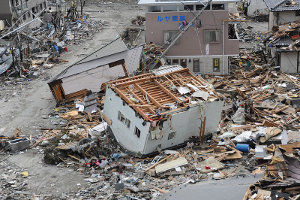Insurance and reinsurance pools
Pools are generally specialized. Specialization can be through:
- Class of business: fire, marine, bond pools, ...
- Event: natural catastrophes pools, terrorism, ...
Pools' benefits
- Pools mobilize substantial capacities
- They provide a technical expertise and a know-how
- They make market regulation possible
- They provide insurance solutions to specific risks
- For reinsurers, pools focus risks on a defined source, thus, restricting exposure accumulation emanating from different insurers' treaties.
Related article: | Insurance pools in Africa
Coinsurance pool
 It is made up of insurers bound by a transfer cession agreement. On the establishment of the pool, the affiliates define, among other issues, the scope of the agreement, the class of business concerned and the capacity granted by each insurer.
It is made up of insurers bound by a transfer cession agreement. On the establishment of the pool, the affiliates define, among other issues, the scope of the agreement, the class of business concerned and the capacity granted by each insurer.
The share of each member shall depend upon the capacity he provides for the pool. Premiums and claims are allocated according to the share of each insurer within the pool.
The pool is generally run by the insurer who has the biggest participation. The risks accepted may emanate from the pool's member companies or from others.
Some coinsurance pools include insurers and reinsurers. It is precisely the case of pool Assurpol (France) which covers environment-related risks.
Co-reinsurance pool
It includes the companies performing reinsurance operations.
It can operate as a coinsurance pool. The pool's members grant capacity and nominate an underwriter who accepts risks on behalf of all affiliates.
Premiums and claims are allocated among the different reinsurers according to the percentage of their rate of participation in the pool.
A co-reinsurance pool can also operate on the basis of the premiums ceded by each member. As such, the pool is designed to jointly reinsure treaties or facultatives that each member underwrites on its own. The share of each reinsurer depends on the amount of the premium it cedes to the pool. As premium volumes vary each year, members' shares are fluctuating regularly.
The coverage of specific classes of business
Some classes of business are prone to the development of coinsurance and co-reinsurance pools.
The cover of several kinds of risks requires that substantial financial and technical capacities be jointly made available. That is particularly the case of aviation, construction and pollution risks.
In France, decennial liability insurance has required, and for several decades, the establishment of specialized bodies to carry out pricing, underwrite and manage construction risks.
Coinsurance and co-reinsurance pools have the advantage of regulating the market and providing a joint solution to the coverage of risks that an insurer, alone, is unable to underwrite.
Coverage of risks generally excluded from reinsurance treaties
Exclusions imposed by reinsurance treaties push insurers to pool up and to establish pools in order to cover some specific risks or events: terrorism, nuclear risks, pharmaceutical risks, pollution, ...
These coinsurance or co-reinsurance pools may have specific reinsurance cover.
Assurpol in France, Perm in Spain, NMP in Holland, Inquinamento in Italy are examples of pools covering pollution risks.
Coverage of catastrophic events
 Public authorities are in favor of these types of covers in order to protect people from heavy losses due to natural catastrophes, and to reduce the pressure on the state budget.
Public authorities are in favor of these types of covers in order to protect people from heavy losses due to natural catastrophes, and to reduce the pressure on the state budget.
These pools are found in numerous countries. France, Turkey, Iran, Australia, Algeria, some of USA states are examples showing how capacities have been joined as pools to cover risks pertaining to natural catastrophes.
In this respect, the State may intervene either indirectly through a national reinsurer or a dedicated body, or directly by offering a guarantee to the pool or additional capacity apart from the one mobilized by the pool.
The French pool
 This system provides all insured with protection against natural catastrophes. For the guarantee to be effective, the state of natural catastrophe has to be declared by inter-ministerial decree. The scheme established is a system of mutualization: anyone having underwritten a property, business interruption or motor insurance policy is required to pay contributions even if that person is not exposed.
This system provides all insured with protection against natural catastrophes. For the guarantee to be effective, the state of natural catastrophe has to be declared by inter-ministerial decree. The scheme established is a system of mutualization: anyone having underwritten a property, business interruption or motor insurance policy is required to pay contributions even if that person is not exposed.
The cover is financed by a an additional premium, at a standard tariff, on motor insurance policies as well as on property insurance policies. Insurers incorporate in the basic contracts clauses extending their guarantees to natural catastrophes.
The Caisse Centrale de Réasurance (CCR), benefiting from the State's unlimited guarantee for the coverage of natural catastrophes in reinsurance, is playing a key role in this system. It provides the market insurers with a quota share cover. The retention of 50% supported by insurers is covered by an unlimited stop loss offered by CCR.
The Algerian pool (Algerian Catastrophe Insurance Pool-ACIP)
In Algeria, natural catastrophe insurance has been compulsory since September 1st, 2004. Four events are covered: earthquakes, floods, tempests and landslides. The State has to declare the situation of natural catastrophe. The guarantee is distributed by all insurers on the market who apply a common tariff.
Upon the occurrence of a claim, a deductible of 10% for industrial and commercial risks and 2% for housing risks is applied.
The reinsurance of the local market is organized by the Caisse Centrale de Réassurance (CCR) which runs the ACIP pool. Each insurer has a quota-share treaty with a capacity of 2.5 billion DZD (33.9 million USD) of which he retains 30%. The direct insurer's retention is protected by an unlimited stop loss treaty.
The 70% quota-share accepted by CCR is covered by a programme of three excess of loss treaties placed on the international market. In 2009, the capacity of this program amounted to 146 million dollars with a priority of 4 million USD.

The Turkish pool (Turkish Catastrophe Insurance Pool-TCIP)
Unlike the French and Algerian pools, TCIP covers only earthquake risks. This compulsory cover has been marketed by local insurers since 2000. The pool is run by Eureko. The amounts insured are limited to 75 000 Turkish pounds (50 220 USD) per dwelling. Sums above 75 000 Turkish pounds (50 220 USD) may be underwritten by insurers on a facultative basis. A 2% deductible of the insured sums is applied for every claim. Insurers benefit from a commission of 12.5% to 17.5% on the written premiums.
Numerous risks are excluded from the guarantee offered by TCIP. The items that are not covered by the insurance obligation are: buildings belonging to civil service, country buildings, buildings designed for commercial or industrial use, buildings under construction.
Tariffs are defined according to the extent of exposure to risks. Insurers have defined five risk areas and three kinds of constructions. In 2009/2010, 15 rates have been in force.
| Non-cresta zone | |||||
|---|---|---|---|---|---|
| Zone 1 | Zone 2 | Zone 3 | Zone 4 | Zone 5 | |
Kind of construction | % | % | % | % | % |
Concrete | 2.2 | 1.55 | 0.83 | 0.55 | 0.44 |
Bricks and/or stones | 3.85 | 2.75 | 1.43 | 0.6 | 0.5 |
Others | 5.5 | 3.53 | 1.76 | 0.78 | 0.58 |
The earthquake insurance premium is calculated as follows:
Square meter price x area of dwelling x tariff according to the zone and kind of construction
The sums insured are obtained by multiplying the square meter price (see below) by the area of dwelling.
in TRY
|  |
The total number of dwellings covered enables Eureko to assess reinsurance needs, thus, protecting the pool. This one year renewable cover is very much like a stop loss treaty of a capacity of 1.325 billion euros in excess of 175 million euros in 2009.
The cover of terrorism risk
 In France, cover against terrorism and attacks is mandatory. The Insurance and Reinsurance Management of Attacks and Terrorist Acts Risks (GAREAT), has provided a solution for this kind of risks since 2001. It gathers within a co-reinsurance pool public and private partners: insurers, reinsurers and the State via CCR. The pool provides a one-year renewable unlimited cover thanks to a stop loss treaty offered by CCR. GAREAT includes insurance companies members of the French Federation of Insurance Companies (FFSA), the Pool of Mutual Insurance Companies (GEMA) and the foreign insurers operating in France.
In France, cover against terrorism and attacks is mandatory. The Insurance and Reinsurance Management of Attacks and Terrorist Acts Risks (GAREAT), has provided a solution for this kind of risks since 2001. It gathers within a co-reinsurance pool public and private partners: insurers, reinsurers and the State via CCR. The pool provides a one-year renewable unlimited cover thanks to a stop loss treaty offered by CCR. GAREAT includes insurance companies members of the French Federation of Insurance Companies (FFSA), the Pool of Mutual Insurance Companies (GEMA) and the foreign insurers operating in France.
Insured risks pertain to property, banker's blanket bond, marine hull and aviation insurance whose insured amounts are below 1 million Euros. Personal line risks are excluded just like bodily injury, third party liability, war risks, strikes, riots, acts of vandalism, thefts and looting following an attack.
In 2008, the pool was covered by a stop loss programme of height layers, the first of which worth 0 to 400 million Euros, which stands for the pool's retention. The last unlimited layer is wholly placed within CCR which benefits from the State's guarantee. The premiums ceded to the pool related to every fire policy.
In Germany, a company named Extremus has been established to manage terrorism risks. It is a partnership between the State, industrialists and the insurers who provide a capacity of 10 billion Euros, 8 billion Euros of which are covered by the State, 2 billion by the insurers. This protection covers material damages incurred by industrial property and buildings whose insured value does not exceed 25 million Euros.
 In the United States, the Terrorism Reinsurance Act provides a guarantee against terrorist acts of foreign inspiration. Within this framework, insurers can be covered by federal funds up to 100 million dollars per year.
In the United States, the Terrorism Reinsurance Act provides a guarantee against terrorist acts of foreign inspiration. Within this framework, insurers can be covered by federal funds up to 100 million dollars per year.